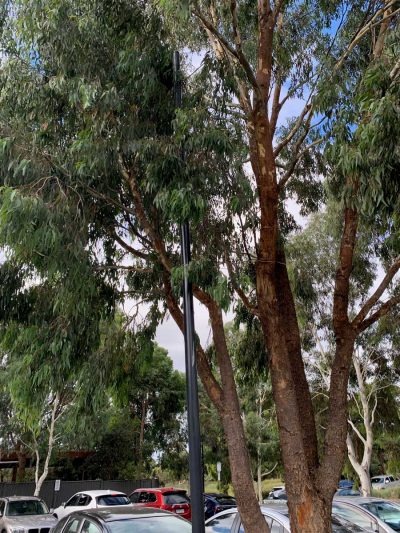An example of this can be seen in the image below with the light fitting located in the tree canopy as it has reached full maturity. The effect of this is the car park is now non-compliant, the light illuminating the tree at night affects the trees seasonal change and animals cannot nest in the trees canopy. A simple site visit to scope out the project would have fixed this issue.
Good lighting design is a simple process if the steps below are followed. Firstly, we must establish the reason why we are using lighting in a particular area, and once this is done the correct type of lighting can be selected.
There are many reasons for using external lighting, below are some of the more common.
- Usability – to continue using a space during night time. This could include sports activity or work.
- Safety – to allow safe movement.
- Security – to reduce the risk of crime.
- Visual Enhancement – to highlight a particular external component or landscape area to make it stand out at night time.
Once we know the reason why we are lighting a certain area, we can then select the most suitable type of lighting to achieve our goal. The most common types of lighting are listed below.
- Pole top lighting. This is the most common type of lighting and is used for a variety of applications. Local parks, car parks, roadways, will all typically use this kind of lighting.
- Similar to pole top lighting, floodlights are used when a lot of light is required. Applications such as sports fields and work sites will generally use floodlighting to ensure the area is suitably illuminated to undertake the relevant activity.
- Bollard lighting. Bollards are ideal for smaller areas such as gardens and short paths where just a low level of light is required for safe movement or to provide some accent lighting to a garden bed for example.
- Not as common as the other types of lighting, an uplight will be used for feature lighting to wash up a wall or the underside of a tree. Uplighting generally provides a lot of spill light, so careful consideration will need to be given to glare shields and beam distributions.
After selecting the most appropriate light source, it is time to undertake a lighting design. It isn’t just a case of spacing out some lights and turning them on, there are a number of potential issues that need to be considered. AS1158 is the Australian Standard for Lighting of Roads and Public Spaces and will need to be adhered to. Furthermore, light pollution is a growing problem and can have negative impacts on both us and the local wildlife. By following AS1158 and combining it with the 5 key steps below, we can ensure the lighting we design is functional, healthy and aesthetically beautiful.
- Is light actually required? This sounds pretty obvious but is often overlooked. Consider the impact the light will have on surrounding areas, and if there is any wildlife that could be negatively affected. It may be the case no lighting is required.
- Once it has been determined that lighting is required, ensure that the lighting is only being directed where it is required. Spill lighting is a huge issue. Consider using shields and different beam spreads to ensure the light is directed to where it is required and nowhere else.
- Only use the amount of light you need. Light doesn’t have to be bright and blazing. Consider using as low a level as you require and no more.
- Use controls to select when the lights are on. They may not be required to be on all night. By using timers, sensors and dimmers, light can be controlled so it is only on when it is needed.
- Use a warmer light colour. Cooler colours contain blue-violet light which can have harmful impacts on the local wildlife.
By following this procedure, not only will your lighting design be fully compliant, you will also be providing an efficient, fit for purpose solution with minimal negative impacts on the environment. Engaging a reputable complete lighting solution specialist such as Lighting & Electrical Distributors will ensure a successful outcome for all concerned.
Our next editorial will examine in more detail the adverse effects of artificial light on the environment.
Image: Valley Lake Boardwalk
Photography: Lighting & Electrical Distributors




